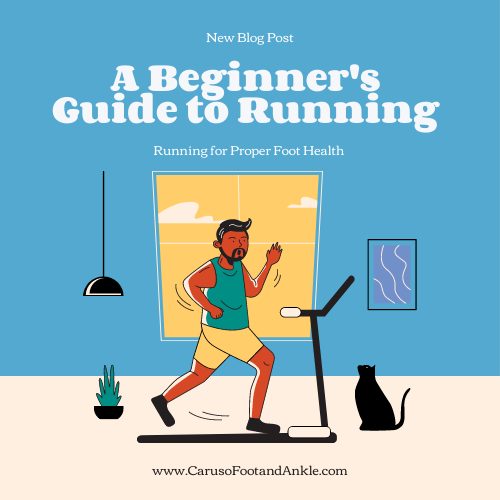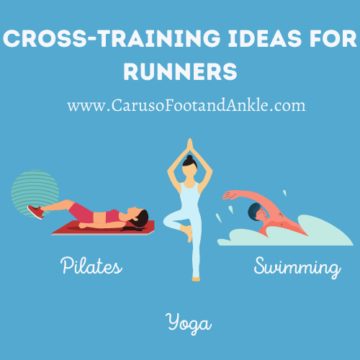

Healthcare professionals can’t deny the immense benefits of running. From increasing your lifespan to improving your sleep, your quality of life advances when you prioritize physical activity. Running is also a relatively inexpensive sport that you can do almost anywhere. All you need is a good pair of shoes to lace up and space to move.
The pastime has significantly increased in popularity after the COVID19 pandemic when people looked to get exercise outside the house. That’s why almost 60% of active adults have chosen outdoor activities such as running as their exercise of choice, according to the 2021 Fitness Trends Global Report.
If running is something that sparks your interest and has been an approved activity by your doctor, add this exercise into your regimen with a plan! It’s critical to do your research for any new program to understand the safety requirements. Here is a beginner’s running guide to running to tackle this sport effectively from the start and ensure proper foot health!
Find Your Why
Running has a stereotype of not being for the faint-hearted. As your body gets used to the activity and builds up cardio, this exercise will be strenuous. In these beginning stages, you’re going to need to have a ‘why’ to keep you motivated.
Did you take on this sport to increase your heart health? To gain energy to keep up with your kids? To shed a few pounds? To boost your mood? Whatever it may be, keep this why in your back pocket and think about it on the days you want to quit.
It’s also helpful for beginners to have something to train for! Look for 5k’s or other races in your local area to sign up for with your friends. Find a proper running plan and stick to it for motivation. When training, think about how you feel after you complete the race!
Work Up Slowly
It is critical not to jump straight into running miles at a time when your body isn’t used to it. Ramping up too quickly can lead to injuries such as shin splints, stress fractures, Achilles Tendonitis, and more! Both seasoned and novice runners should be wary of rapidly increasing intensity. Beginner runners can start with run-walk running intervals to ease into things.
Runner’s World suggests following the 10-15 rule. Here, athletes will calculate 10-15% of what they want their weekly mileage goal to be. Each week they will not exceed that number as they add more miles to their regimen.
If you are training for a competition, look up beginner training plans for whichever type of race you are looking to participate in, so you can safely work to your goal. There are plenty of free online training sources for 3ks, 5ks, 10ks, and half marathons. As you start working up to longer distances, be sure to incorporate plenty of walk breaks.
If you are running for exercise, always listen to your body. If something feels off, ensure that you take a break.
Find Specific Running Shoes for Your Foot Type
Everybody’s foot structure is different. Of course, you should always wear shoes specific to your sport, but finding footwear that supports your foot type will help prevent injuries and keep you running longer. Contact your podiatrist, who can give you recommendations on shoes or customized orthotic inserts to support your high or low arches!
Alternatively, you can head to your local running store, where staff can measure your foot and walking patterns. They will make suggestions on shoes according to what they have in stock. It may also be advised for you to select a pair that is half a size larger than usual. Here, your feet have a bit more space for wiggle room as you move.
Remember to replace your shoes after running 300 to 500 miles. In addition, you should also consider replacing footwear when you develop new aches or form new blisters. The soles wear down and give you less support. It is recommended to track your runs on apps like Nike Run Club or your smartwatch to keep motivated and have visibility over your total mileage!
Mix Up Where You Run
One of the best advantages of running is that you can do it almost anywhere! Therefore, mixing up where you run will prepare you to perform on a variety of terrains. At first, runners should take extra care in listening to their bodies to feel out which surfaces feel best in their feet and legs. There are different pro’s and con’s to different terrains, such as:
- Asphalt and Concrete: These are some of the most common terrains for runners as they exercise through their neighborhoods, cities, and paved parks. While these roads are great for convenience, the repetitive hard impact on these surfaces can cause injuries like stress fractures, shin splints, heel pain, or other foot problems.
- Grass and Mountain Trails: These soft surfaces are much kinder to your bones and joints and help cushion your feet! However, runners should be wary of slippery mud and uneven surfaces to avoid sprained ankles.
- Treadmill: Many turn to this device in the cold winter months when running outside seems unbearable. While running in the same spot can be boring after a while, newer treadmills provide cushions and springs on their track that can help with impact.
Try out these different terrains and see what works best for you. Never force your body to endure something that doesn’t feel right!
Warm-up, Cool-down, and Cross-train
Proper running etiquette includes taking time to warm up, cool down, and implement other training! Your body will protest if you jump straight into running without doing anything else. Taking on these extra steps helps prevent injury and will help you with performance.
Warming-up: When you warm up, you help loosen up your muscles and joints before taking on this strenuous activity. Oxygen is more easily distributed throughout the body due to increased blood flow. Therefore, you will be more limber and reduce your risk of injury and side stitches on your run.
When warming up, ensure you are performing dynamic repetitions instead of static drills. Dynamic exercises are active stretches that help develop the joint’s full range of motion and get the heart rate up. Follow along with this five-minute dynamic warm-up video before your next run.
Cooling-down: Stretch after exercising to avoid injury and reduce soreness. You have the opportunity to increase your flexibility since your muscles are looser after a run. Here is the time to incorporate static stretching where you hold a single pose for a period of time (typically 30-60 seconds). Follow along with this post-run stretching video for a better recovery.
Cross-training: To become a better runner, you will need to implement cross-training into your routine. Mixing up your workouts decreases boredom and helps you increase your overall health by working out different areas of your body. Supplement your training with at least 30 minutes of other activities you might want to try. This could include
- Yoga
- Strength training
- Pilates
- Swimming
 Not only does a variety of training keep things interesting, but it helps reduce injury too. Therefore try out different things and find what you enjoy!
Not only does a variety of training keep things interesting, but it helps reduce injury too. Therefore try out different things and find what you enjoy!
You don’t have to participate in marathons to be considered a runner. Begin your journey today by starting small and taking the time to work your way up. All you need to do is put one foot in front of the other!
Are you wondering if you are healthy enough to start running or have any more questions about this process? Contact our office, and we would be happy to answer any questions you may have! What is your motivation to run? Let me know on Twitter!